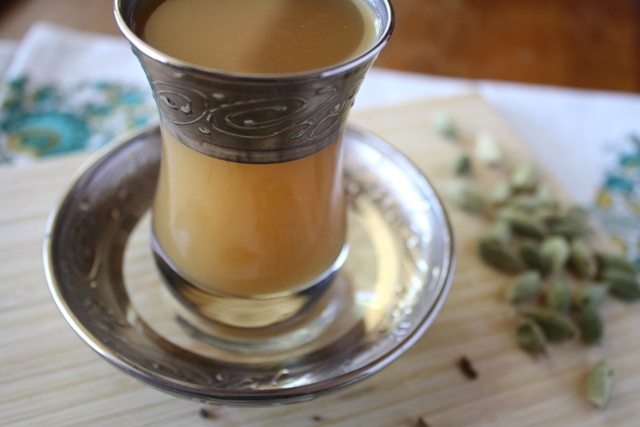My first sip of chai occurred during one of those life-changing moments that remains firmly planted in my memory—a wonderful experience which comes back in single, happy frames each time I enjoy this spicy beverage. It takes me back to the bustling streets of Africa.
I was earning my Master’s degree in African Studies when I received a Fulbright Hayes scholarship to study Zulu for the summer in South Africa. It was a spirited summer of intense adventure—the kind for which youth are built.
That summer, I learned the clicks of the poetic Zulu language.
I lived in a township where I walked half a day through the dry, red earth with my host sister to visit her family friend in a shack with a tin roof and cockroaches that swarmed the kitchen.
I lived in a rural village where no one spoke English. I shared a bed with my host sister, and we slept with the covers pulled over our heads to keep the cold out of our lungs at night. Each morning, I bathed in a tiny pot of water that covered no more than the bottoms of my feet while I stood naked and exposed to the brisk breezy morning. I ate pudgy amagwinya, Zulu donuts, and complicated curry blends with cabbage and potatoes. The vegetables were grown by my host mom.
When summer was drawing to a close, I traveled to Zanzibar Island in East Africa to visit a college friend. Zanzibar was paradise. Coming from the cold winter of South Africa, I relished the brutal equatorial heat. My friend and I stayed in a cabana on the crisp white beach next to an ocean with such a crystal blue hue that it felt like I was in a postcard.
Then, we returned to Zanzibar City, a bustling place that felt to an outsider like me as if someone had taken a handful of houses and dumped them with a thud onto the streets, where they would remain without row or structure. I was lost in the hubbub for my entire visit without ever knowing which way was east or west. But I didn’t care. I loved the warm chaos and the streets filled with the smells of ocean, spice, pots bubbling and fires burning.
I remember my friend, Shannon, moving swiftly through the streets. She was familiar with them, with the local cuisine. She would stop to buy a piece of fruit for me to taste or some local nibble. I remember her passing me my first rambutan fruit, and as she hustled along, I asked, “How do you eat it? Do you eat the whole thing?”
“Just put it in your mouth. You’ll love it,” she said, briskly moving to stay out of the way of an oncoming bicyclist.
I tossed the fruit in my mouth. Dense spikes poked at my tongue and cheeks. I gnawed at the fruit like a bone, waiting for the magical flavor my friend had promised.
“Do you like it?” she asked, anxious for my reaction.
“It tastes… kind of like tree bark,” I said.
Suddenly Shannon stopped walking and looked at me.
“You didn’t eat the skin, did you?” she cried.
“Was I not supposed to?” I muttered; a dumb tourist. “No wonder!”
This time, Shannon pulled me off the main road and under the awning of a shop. She took another rambutan and skillfully pulled apart the tough, spiked skin. Inside, a soft, white fruit glistened. She handed it to me and I slurped. Heaven!
With my fruit folly out of the way, Shannon and I slipped into a nearby shop. The strong aroma of spices and grilled meat poured from the kitchen. Our meal came with the traditional tea, or cha, that I would learn was served with every meal. Having lived in Denmark for a year during high school, I was quite fond of drinking tea. Yet, never before had anyone served me tea like this.
Instead of an earl grey or English breakfast, this black tea was billowing with flavor: the kick of cinnamon, the roll of cardamom, the zing of ginger.
“What is this? It’s wonderful!” I exclaimed.
“That’s how they serve their tea here,” explained Shannon. “This is Spice Island—it’s all grown fresh here, and everyone uses a different blend to make their tea. You’ll never know what you’re going to get.”
I was in a place of dreams—where the exotic spices of my local grocery store back in Illinois were growing, some of them wild, right here in Zanzibar!
That tiny cup of tea awoke my taste buds. I’ve been drinking chai tea ever since.
If you’re accustomed to the chai teas of American chain coffee shops, you’ll need to set those syrup-laden beverages aside. My chai tea recipe is based on the chai of Zanzibar, Spice Island. Sure, I add a touch of local honey and a splash of coconut milk, but the intent of this drink is to showcase fresh spices. The heat and play of spice should outshine anything else in the cup.
Use the freshest spices you can find to make this tea. Don’t use anything that has passed its expiration date. I have found the freshest spices online at Penzey’s or Market Spice. Cardamom, in my experience, is the most critical ingredient in chai, so don’t skimp on it.
Homemade Iced Chai Tea Latte with Coconut Milk
Ingredients:
2 cups Danedar strong Mamri black chai tea (found in Indian grocery stores)
1/2 cup whole green cardamom pods
1/4 cup Madagascar whole cloves
scant 1/4 cup China cracked dry ginger
1/4 cup cinnamon chips or broken cinnamon sticks
1 Tablespoon Spanish cracked anise seeds
1 Tablespoon rainbow whole peppercorns
1 Tablespoon whole grains of paradise
Local honey
Coconut milk
Instructions:
Combine all the dry ingredients in a large bowl and stir together. Pour into a large glass jar. This tea mixture will keep for several weeks.
To make your chai latte, bring a pot of water to a boil. In an empty tea pot, place 1 Tablespoon of the chai tea blend for every 2 cups of boiling water. Pour boiling water over tea blend, cover, and steep for 3-5 minutes.
Pour the steeped tea through a strainer and into a mug (if making iced chai, only fill the mug half way to leave enough room in the mug to add ice later). For each cup of brewed tea add 2 teaspoons honey and 1 Tablespoon coconut milk. Stir until honey is dissolved.
Either drink immediately, or for iced chai, add about 1/2 cup of ice.
Yield: 3 cups dry chai tea mix







